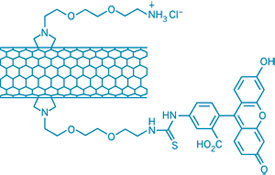Advertisement
Grab your lab coat. Let's get started
Welcome!
Welcome!
Create an account below to get 6 C&EN articles per month, receive newsletters and more - all free.
It seems this is your first time logging in online. Please enter the following information to continue.
As an ACS member you automatically get access to this site. All we need is few more details to create your reading experience.
Not you? Sign in with a different account.
Not you? Sign in with a different account.
ERROR 1
ERROR 1
ERROR 2
ERROR 2
ERROR 2
ERROR 2
ERROR 2
Password and Confirm password must match.
If you have an ACS member number, please enter it here so we can link this account to your membership. (optional)
ERROR 2
ACS values your privacy. By submitting your information, you are gaining access to C&EN and subscribing to our weekly newsletter. We use the information you provide to make your reading experience better, and we will never sell your data to third party members.
Biological Chemistry
Nanoneedles Pierce Cells
Functionalized carbon nanotubes are taken up by cells via a possible universal mechanism
by Michael Freemantle
January 31, 2007

The uptake of functionalized carbon nanotubes by living cells does not depend on cell type or on the nature of the chemical moieties grafted onto the tubes, according to a new study (Nat. Nanotechnol., DOI: 10.1038/nnano.2006.209). The research also provides evidence that nanotubes act like nanoneedles when they penetrate cell membranes.
The work, which could help to establish the potential for carbon nanotubes for biomedical applications, was carried out by team leader Kostas Kostarelos, deputy head of the Centre for Drug Delivery Research at the University of London's School of Pharmacy; Alberto Bianco at the CNRS Laboratory of Immunology & Therapeutic Chemistry in Strasbourg, France; Maurizio Prato of the University of Trieste, in Italy; and their coworkers.
"Our work elucidates a possible universal mechanism for cellular uptake and internalization of functionalized carbon nanotubes that may involve processes other than endocytosis," Kostarelos says.
The team first solubilized single-walled and multiwalled carbon nanotubes by functionalizing them with hydrophilic amino groups, using 1,3-dipolar cycloaddition of azomethine ylides. They then covalently linked the nanotubes to fluorescent probes and either anticancer or antibiotic agents. The probes enabled the researchers to track and image the nanotubes inside the cells.
"We showed that various types of functionalized carbon nanotubes move through the cells as individual nanotubes or as small bundles, even under conditions that inhibit endocytosis," Kostarelos says. "The potential of functionalized carbon nanotubes to act as nanoneedles that pierce plasma membranes and translocate directly into the cytoplasm without causing cell damage or death is significant for a variety of biomedical and biotechnological applications."
The precise mechanism of cellular uptake of functionalized nanotubes is likely dependent on factors such as length and diameter of the carbon nanotubes, the extent of nanotube aggregation, as well as the density of the surface functional groups, says Stanislaus S. Wong, associate professor of chemistry at the State University of New York, Stony Brook.
The findings will "undoubtedly have impact in the environmental health sciences, exposure assessment, hazard identification, and analysis of risk," according to Martin A. Philbert, professor of toxicology at the University of Michigan, Ann Arbor. "The ability to manipulate nanometer-scale materials at the molecular level holds the promise of conferring specificity of cellular delivery and the reduction of collateral nuisance injury to neighboring cells," he comments. "In the context of environmental health, the scientific community will have to pay close attention to those physicochemical properties of engineered nanomaterials that defeat or circumvent normal cellular processes and lend themselves to indiscriminate penetration of biological barriers, tissues, and cellular systems."



Join the conversation
Contact the reporter
Submit a Letter to the Editor for publication
Engage with us on Twitter